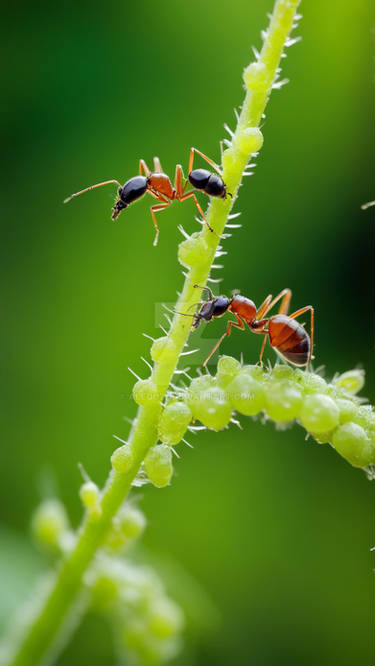ShopDreamUp AI ArtDreamUp
Deviation Actions
Description
Finally got a chance to shoot the Flightless Tiger Beetle and do a direct comparison with the cricket! Top is a Tricondyla, flightless Tiger beetle and bottom is a Condylodera Tricondyloides, a cricket that mimic Tricondyla. What amazing mimicry!
Top View [link]
Batesian mimicry is a form of mimicry typified by a situation where a harmless species has evolved to imitate the warning signals of a harmful species directed at a common predator. It is named after the English naturalist Henry Walter Bates, after his work in the rainforests of Brazil.
Batesian mimicry is the most commonly known and widely studied of mimicry complexes, such that the word mimicry is often treated as synonymous with Batesian mimicry. There are many other forms however, some very similar in principle, others far separated. Of note, it is often contrasted with Müllerian mimicry, a form of mutually beneficial convergence between two or more harmful species. However, because the mimic may have a degree of protection itself, the distinction is not absolute. It can also be contrasted with functionally different forms of mimicry. Perhaps the sharpest contrast here is with aggressive mimicry, where a predator or parasite mimics a harmless species, avoiding detection and improving its foraging success.
The organism imitating the protected species is referred to as the mimic, while the imitated organism is known as the model. The receiver mediating indirect interactions between these two parties is variously known as the signal receiver, dupe or operator. By parasitizing the honest warning signal of the protected species, the Batesian mimic gains the same advantage, without having to go to the expense of arming themselves. The model, on the other hand, is disadvantaged, along with the dupe. If imposters appear in high numbers, positive experiences with the mimic may result in the model being treated as harmless. Additionally, in higher frequency there is a stronger selective advantage for the predator to distinguish mimic from model. For this reason, mimics are usually less numerous than models. However, some mimetic populations have evolved multiple forms (polymorphism), enabling them to mimic several different models. This affords them greater protection, a concept in evolutionary biology known as frequency dependent selection.
Batesian mimicry need not involve visual mimicry, but can employ deception of any of the senses. For example, some moths mimic the ultrasound warning signals sent by unpalatable moths to bat predators, a case of auditory Batesian mimicry. A cocktail of deceptive signals may also be used. The distinction between Batesian mimicry and crypsis is clear: the mimic is noticed, but treated as something it is not. On the other hand, camouflaged prey would often create the same effect by being invisible. While model and mimic are often from related taxa, mimicry of very distant relatives is also known. The majority of Batesian mimics are insects.
Source [link]
Top View [link]
Batesian mimicry is a form of mimicry typified by a situation where a harmless species has evolved to imitate the warning signals of a harmful species directed at a common predator. It is named after the English naturalist Henry Walter Bates, after his work in the rainforests of Brazil.
Batesian mimicry is the most commonly known and widely studied of mimicry complexes, such that the word mimicry is often treated as synonymous with Batesian mimicry. There are many other forms however, some very similar in principle, others far separated. Of note, it is often contrasted with Müllerian mimicry, a form of mutually beneficial convergence between two or more harmful species. However, because the mimic may have a degree of protection itself, the distinction is not absolute. It can also be contrasted with functionally different forms of mimicry. Perhaps the sharpest contrast here is with aggressive mimicry, where a predator or parasite mimics a harmless species, avoiding detection and improving its foraging success.
The organism imitating the protected species is referred to as the mimic, while the imitated organism is known as the model. The receiver mediating indirect interactions between these two parties is variously known as the signal receiver, dupe or operator. By parasitizing the honest warning signal of the protected species, the Batesian mimic gains the same advantage, without having to go to the expense of arming themselves. The model, on the other hand, is disadvantaged, along with the dupe. If imposters appear in high numbers, positive experiences with the mimic may result in the model being treated as harmless. Additionally, in higher frequency there is a stronger selective advantage for the predator to distinguish mimic from model. For this reason, mimics are usually less numerous than models. However, some mimetic populations have evolved multiple forms (polymorphism), enabling them to mimic several different models. This affords them greater protection, a concept in evolutionary biology known as frequency dependent selection.
Batesian mimicry need not involve visual mimicry, but can employ deception of any of the senses. For example, some moths mimic the ultrasound warning signals sent by unpalatable moths to bat predators, a case of auditory Batesian mimicry. A cocktail of deceptive signals may also be used. The distinction between Batesian mimicry and crypsis is clear: the mimic is noticed, but treated as something it is not. On the other hand, camouflaged prey would often create the same effect by being invisible. While model and mimic are often from related taxa, mimicry of very distant relatives is also known. The majority of Batesian mimics are insects.
Source [link]
Image size
775x1024px 412.19 KB
© 2012 - 2024 melvynyeo
Comments10
Join the community to add your comment. Already a deviant? Log In
Spectacular comparison, and one of the most amazing mimicries I've seen! Well done!





























